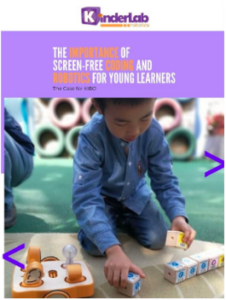Simba: KinderLab Introduces Robots at an Early Age
Our CEO, Mitch Rosenberg, was recently interviewed by Simba Information. The interview, entitled, “KinderLab Introduces Robots at an Early Age” is featured in their May Electronic Education Report.
The article reads:
Companies are offering, and schools are considering, more options for using robots in primary education as research indicates children are capable of STEM learning at an early age.
KinderLab Robotics (Waltham, MA) CEO Mitch Rosenberg told EER that much of STEM education has focused on late elementary and middle school, but robots, which offer physical rather than abstract learning, are uniquely capable of getting younger students excited about STEM.
The most important thing, according to Rosenberg, is to get the entire student population involved in STEM early, before some students decide STEM is not for someone like them. One way to do that is to integrate STEM into other subject areas and to show how building something physical and mechanical can connect to art, design and social issues, while offering the opportunity to learn skills like sequencing and conditional learning.
There are a lot of cool kits out there, but KinderLab is not about robots for play, Rosenberg said. The company has 80 hours of curriculum, with plans to expand to 100 hours in the next three months
What Makes up a Robot Kit
A KinderLab KIBO robot kit comes includes a blank robot form with additional parts that are understandable to a four-year old—for example, wheels that can click in. Metal, plastic and wood elements are included because early learners are attuned to exploring different physical materials, Rosenberg said.
Supplies include pipe cleaners and tissue paper tubes that can turn the robot into a helicopter or a ballet dancer. Sensors give the robot capabilities—if an ear is added the robot can respond to loud noises.
Wooden blocks with pictures represent software code and can be assembled in sequence for the robot’s sensors to read. Children understand the robot is scanning the blocks in the same way bar codes are read at a supermarket, Rosenberg said.
KinderLab continues to add capabilities, like enabling robots to carry multiple marker pens so they can chart their paths as they move. Robots can be built on with other physical components like Legos. At least two more capabilities are planned for 2018.
Once the robot is built, the question becomes what to do with it. Rosenberg said the options range from racing the robots to dressing them to act out a story. Students can learn trouble shooting; it is acceptable to get something wrong and to course correct. They learn both structure and open-ended exploration, as they proceed step-wise acquiring specific skills, but without a specified outcome.
Business Model
KinderLab kits are sold at four price points, between $230 and $500, with the price dependent on how many blocks, motors, sensor modules and art platforms are included. Kits can be purchased individually or bundled for an entire class with teacher materials that include interactive training.
To Rosenberg’s surprise, most education customers select the two highest-priced kits. Customers are curious, he said, but the concept is new to them, so they are asking questions rather than saying what they need.
KinderLab is open to partnerships with content providers and has had some early conversations about those. In April, KinderLab was added to the program list put out by STEMworks, part of the nonprofit research agency WestEd (San Francisco).
KinderLab, founded in 2013, has shipped product to 52 countries and all 50 states. Company revenue grew 30% last year and is on track to grow 40% this year, as more large customers are added.
Read the additional article Robots Coming to Classrooms to Engage Young Students.



















